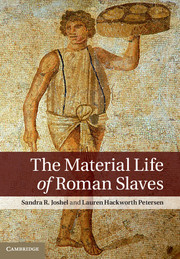Chapter 2 - Slaves in the House
Published online by Cambridge University Press: 05 November 2014
Summary
The past is what we choose to preserve.
—pavel 2011Roman domestic architecture is obsessively concerned with distinctions of social rank, and the distinctions involved are not merely between one house and another . . . but within the social space of the house.
—wallace-hadrill 1994, 10A visit to the houses of Pompeii, Herculaneum, and Ostia is at once a rewarding and disappointing experience for tourists and scholars alike. On the one hand, the extraordinary survival of the houses allows visitors to walk through the domestic spaces of ancient Romans, inviting one to imagine the rituals and practices of everyday life that took place in them. On the other hand, one senses a loss – something is missing. Some of the decoration that adorned the interiors is in situ and subject to the elements, but much is on display or in storage in a museum elsewhere, in private collections, destroyed, or lost, leaving one to piece together the various elements in an attempt to create a whole as effectively as possible. And, of course, the people that once populated these residences are long gone and so, too, are their actions as they negotiated life within them. What remains, the ruins and artifacts, are the physical traces of the inhabitants’ actions, and these, combined with the words of ancient writers, have permitted us to know something about the daily lives, attitudes, and priorities of Romans.
This chapter focuses on the material life of slaves within the Roman house. It attempts to trace the circulation, movement, and choreography of slaves as described in the written sources and as presented in the arrangement of rooms within houses, large and small, at Pompeii, Herculaneum, and Ostia. We also look for the possibilities of slave appropriation of domestic spaces and manipulation of time. To begin, however, it is useful to rehearse the master narratives of Roman houses to demonstrate the extent to which slaves, although central to the functioning of domestic life, have been effectively marginalized and silenced in these narratives – then and now, physically and conceptually. This chapter, as it attempts to shift our point of view and to ask new questions of the remains, then considers the spaces, material culture, and timing of slave tactics in domestic urban settings.
- Type
- Chapter
- Information
- The Material Life of Roman Slaves , pp. 24 - 86Publisher: Cambridge University PressPrint publication year: 2014

